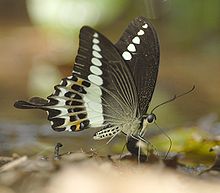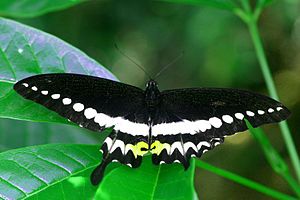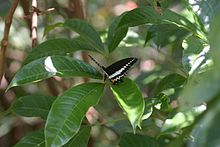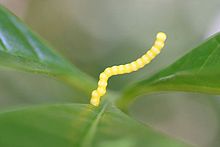- Papilio liomedon
-
Malabar Banded Swallowtail 
Scientific classification Kingdom: Animalia Phylum: Arthropoda Class: Insecta Order: Lepidoptera Family: Papilionidae Genus: Papilio Species: P. liomedon Binomial name Papilio liomedon
Moore, 1874Synonyms Princeps liomedon
The Malabar Banded Swallowtail (Papilio liomedon) is a beautiful member of the Swallowtail family found in southern India. Earlier considered a subspecies of the Banded Swallowtail (Papilio demolion) of South-east Asia but now considered a distinct species.
Contents
Description
Similar to Papilio demolion but distinguishable chiefly by the pale greenish-yellow band that crosses the wings starting from the middle and not from just before the middle of the dorsal margin of the hind wing, also this band is composed entirely of separate spots on the fore wing.[1]
Range
Western Ghats and hills of southern India.
Status
The IUCN Red Data Book records the Malabar Banded Swallowtail as uncommon and not threatened as a species. However a survey in the early nineties by Harish Gaonkar showed the butterfly to be rare but distributed from Kerala to Goa. The butterfly was considered to be common in Karwar in the past. It is not to be found in Maharashtra and Gujarat. It is protected by law in India. [2][3]
Habitat
Generally found in the semi-evergreen and evergreen tropical forests of the Western Ghats where it flies mainly during the monsoon months.
Habits
The males are fond of heavy jungle especially on hilltops. The females fly lower in even thicker jungle. The butterflies visit flowers such as Lantana, Stachytarpheta and Clerodendron.[4]
Lifecycle
There are two to three broods a year. Recorded in Kodagu (Coorg) as having broods from September to October, November to December, and, from April to May. Recorded in Karnataka in July and in September. Males appear to outnumber the females.
The life-history of this insect is given by Messrs. Davidson and Aitken: One of these gentlemen watched a female, P. liomedon, laying its eggs on a tender shoot of a small jungle tree or shrub (Acronychia laurifolia). There were "ten eggs, laid one on top of the other." Of the caterpillars which emerged five days after the eggs were laid, "five passed successfully through all dangers and became beautiful specimens, one female and four males. (This is one of the butterflies of which we rarely find females.) All through their liven these larvae continued gregarious, dispersing occasionally to feed, but always returning to rest side by side on the upper surface of a leaf. The following dates may be interesting. Eggs laid 2 August, hatched 7 August; skins cast (and eaten) 12 August; again 17 August; again 20 to 22 August. The most advanced cast its skin again on the 28th August, became a pupa on the 2nd of September, and emerged on the 15th of September. The others followed within two days. At first the larvae were of an oily yellow colour and bore many pairs of spiny points, but these disappeared with age and after the last moult there were only the short fleshy processes on the 2nd and last segment which characterise the group, and one additional curved pair on the ninth segment. "The colour after the last moult was a clear slaty-blue, changing eventually to a greenish tint, with light brown markings very much the same as those which characterise the rest of the group. The pupa was more abruptly bent back from the middle of the thorax than that of P. erithonius (i. e. P. demoleus) and adorned on the thorax with a sword-shaped horn, fully three-eighths of an inch long, and always bent either to the right or the left. The colour was brown or green and yellow according to situation."[1]
Eggs
The female lays her eggs one over the other in a stick of ten to sixteen. The orange eggs gradually fade to yellow. The pale black of the larval heads appear on the upperside of the eggs on the fourth day. The eggs hatch on the fifth day.[4]
Larva
The larvae live gregariously and are heavily parasitized (up to 90%). The first instar lasts about 5 days, second instar for 4 days, third instar 5, fourth instar 4, about 3 days for the 5th instar and another 3 days for the 6th instar. They begin to pupate after around 22 days of their larval duration.[4]
Pupa
The lower portion of the pupa is yellow or fluorescent green with purple lines. Between the head and the thorax region a projection like a jug-handle is seen. This is distinctive of the species. Below the thoracic region, two yellow spots are seen. The pupal duration is about 15 days.[4]
Foodplants
Acronychia laurifolia and Evodia roxburghiana of the family Rutaceae.[5]
Cited references
- ^ a b Bingham, C. T. 1907. Fauna of British India. Butterflies. Volume 2
- ^ Collins, N.M. & Morris, M.G. (1985) Threatened Swallowtail Butterflies of the World. IUCN. ISBN 2-88032-603-6
- ^ Indian Wildlife Protection Act Schedule 1 Part 4
- ^ a b c d Susanth, C. (2005) Biology of Malabar Banded Swallowtail Papilio liomedon Moore. J. Bombay Nat. Hist. Soc. 102(1):33-37
- ^ Gaden S. Robinson, Phillip R. Ackery, Ian J. Kitching, George W. Beccaloni AND Luis M. Hernández. HOSTS - a Database of the World's Lepidopteran Hostplants [1] Accessed November 2006
Other references
- Evans, W.H. (1932) The Identification of Indian Butterflies. (2nd Ed), Bombay Natural History Society, Mumbai, India
- Gaonkar, Harish (1996) Butterflies of the Western Ghats, India (including Sri Lanka) - A Biodiversity Assessment of a threatened mountain system. Journal of the Bombay Natural History Society.
- Gay, Thomas; Kehimkar, Isaac & Punetha, J.C.(1992) Common Butterflies of India. WWF-India and Oxford University Press, Mumbai, India.
- Kunte, Krushnamegh (2005) Butterflies of Peninsular India. Universities Press.
- Wynter-Blyth, M.A. (1957) Butterflies of the Indian Region, Bombay Natural History Society, Mumbai, India.
See also
Categories:- Papilio
- Butterflies of India
Wikimedia Foundation. 2010.



